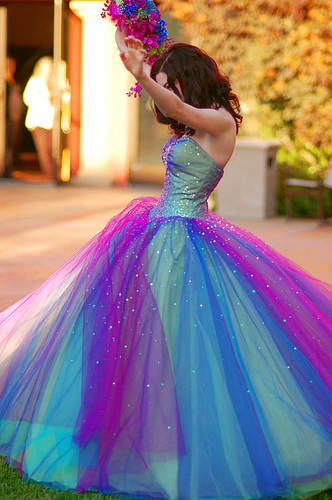De Niña a Mujer

De Niña a Mujer

|
The Quinceaños, or la fiesta Quinceañera, is a rite of passage for fifteen-year-old Latina girls. It is a community and family celebration full of tradition and meaning when a young girl is symbolically escorted into womanhood by her family and the event is witnessed by her community. The word itself comes from the Spanish quince, "fifteen," and años, "years." The origins of the Quinceañera are often attributed to the ancient customs of the Aztecs, but the ceremony and meaning behind it are similar to other ancient cultural initiation rites that occurred throughout the world. Fifteen was the age when many young women left their family home to become wives and then mothers, and almost as though passing through an invisible door, a Latina enters her Quinceañera as a child but emerges as a young woman with new responsibilities. Those who know and love her will see and treat her differently from that day forward. The godparents take a prominent role in the quinceanera celebration, as part of the young woman's "court." The court also includes her parents and up to seven "damas" (maids of honor) and seven chamberlains. For Latinas from Latin America, Spain and Puerto Rico, this is an old and revered tradition. The celebration as we know it today in the United States became popular in the 1930s and continues, even flourishing in communities where custom and ritual rekindle ethnic and family ties. But Quinceañeras, like mostly strongly held traditions, is not a static event, and the ways it is celebrated are changing with the times. Now many girls have combined the "American" concept of "sweet sixteen" with what would have been their Quinceañera. A Barbie Quinceañera doll in some cases replaces the handmade ultima muneca, and families are beginning to celebrate the "coming of age" of their sons, too. These blendings of cultures can be found in many aspects of our traditional lives. Some have to do with the breakdown of traditional life, and some with a world of changing cultural mores. In whatever form it may take, a Quinceñera is a very special event happening only once in a girl’s life, so it is a time for rejoicing in the miracle of life and reaffirming one’s commitment to family, friends, tradition, and community. La Fiesta Quinceañera, or La Fiesta Rosa On the banks of the Mohawk River is the town of Amsterdam, home to one of the oldest and largest Latino communities in upstate New York. Francisca "Panchita" Davila was one of the people who made the trip to Amsterdam in 1960 from her rural home in Salina, Puerto Rico. Her parents were farmers who grew sweet potatoes, yucca, yams, corn, beans, coffee, and breadfruit. She learned the arts of crochet and tailoring from her mother, Mercedes Torres. They worked together at home, embroidering and sewing for the family but also for other people in the village. |
William Robert Shepherd
The Hispanic Nations of the New World : a Chronicle of our Southern NeighborsNorthern California Land Grant from Mexican governor of California
The days of the Dons - excerpts form Two Years Before the Mast
The Old West was heavily influenced by Hispanic contribution
Saga of the Hard-riding Vaqueros, America's First Cowboys.
Esteban the Black Moor of Coronado's Expeditions
Benito Juárez : called "the Abe Lincoln of Mexico"
Why Americans should honor Cinco de Mayo, also
Columbus and the religion issue - a harm or a help?
Profound Arabic impact, via the Moors, on Spanish
The flow of three cultures: old Spain's mystic destiny
A barefoot reformer severely chastened by Inquisition
Incomparable Jimenez : the crowning glory of Alcalá
Somos Primos : Hispanic History and Ancestry Link
Día de la Mujer Latina - Cancer helps and support

La música ranchera es la "Quinta esencia" de la forma de la Canción Mexicana.